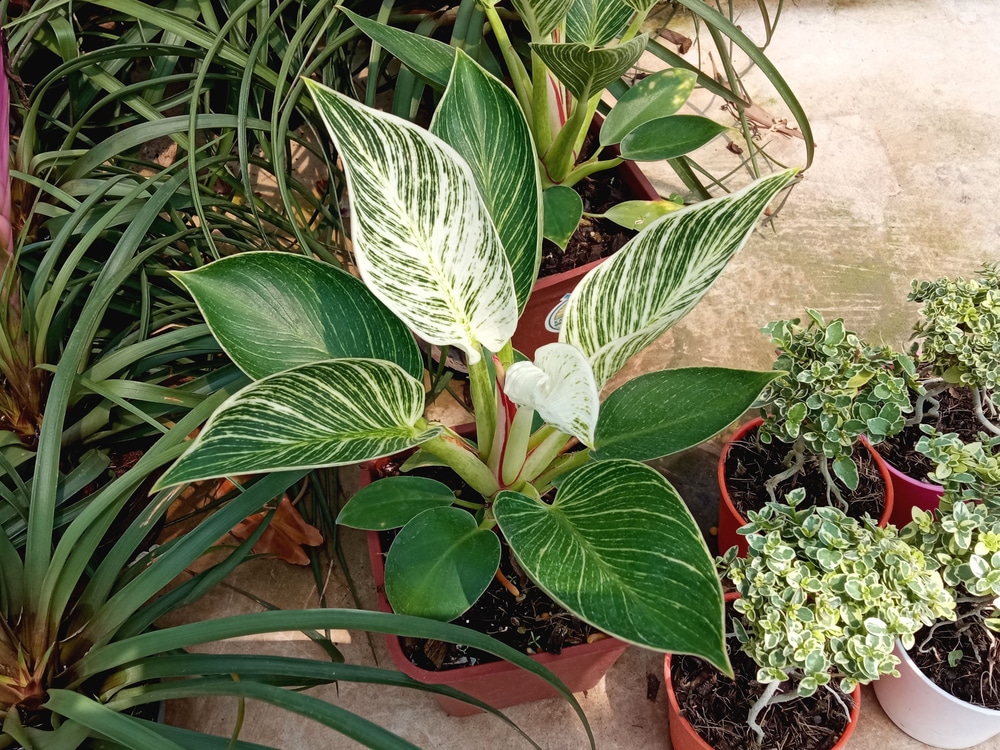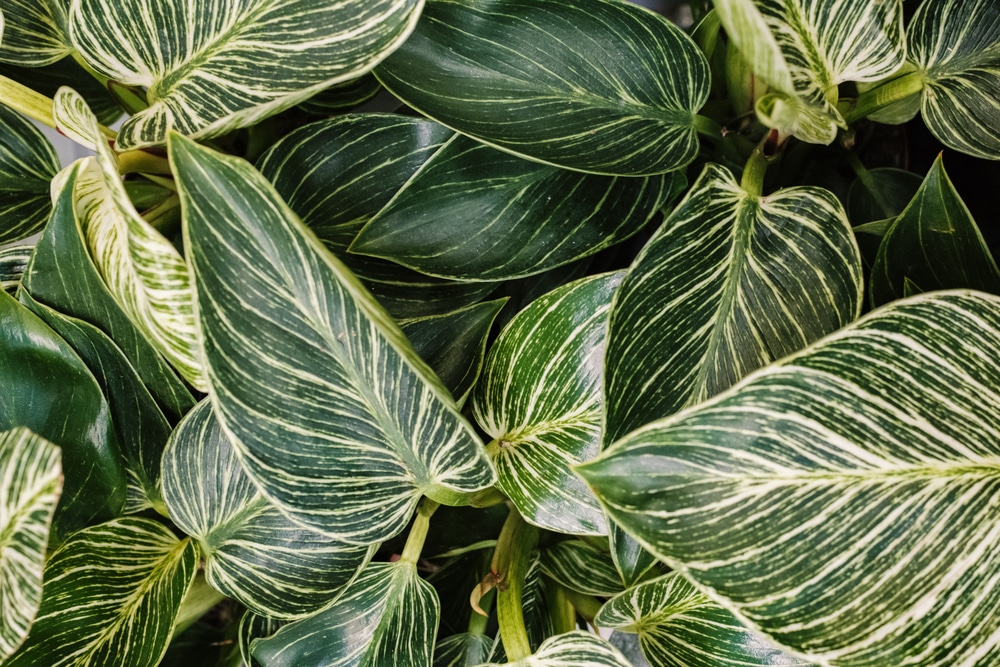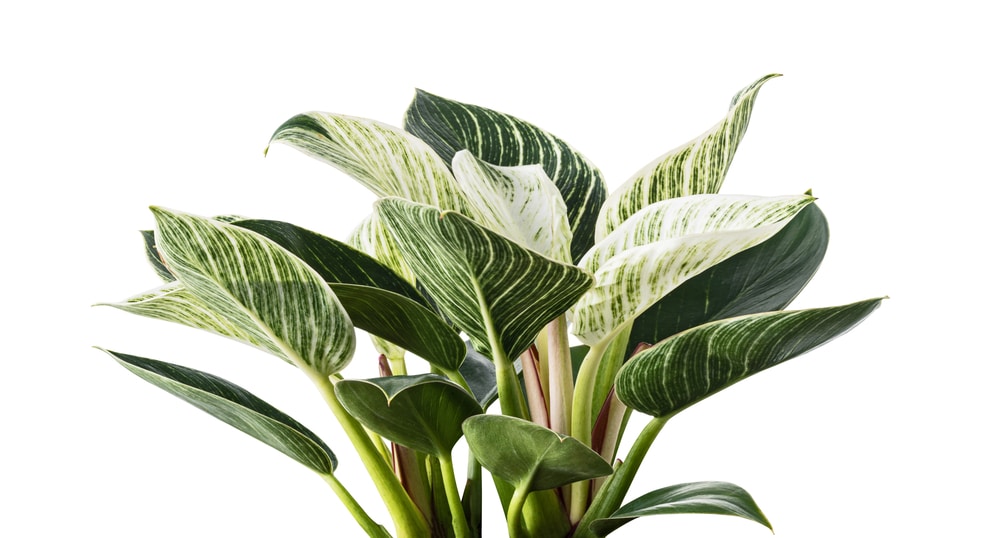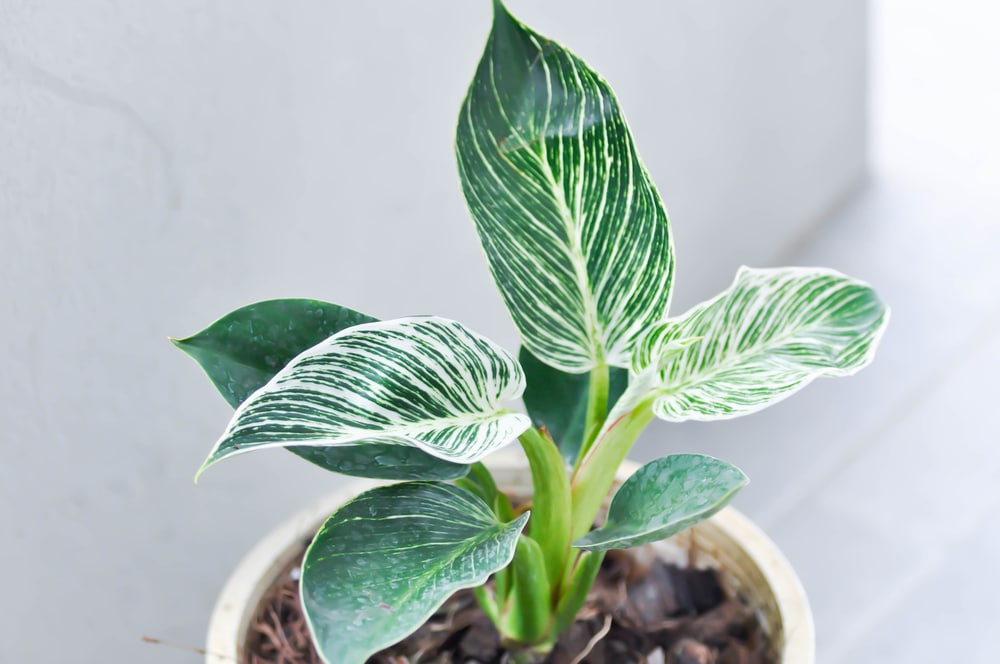The rare and exceptionally stunning Philodendron Birkin is a houseplant worth the effort. It isn’t difficult to care for the Birkin; in fact, that’s the easy part. Acquiring the Philodendron Birkin is the tricky bit.
However, due to its massive popularity, it is becoming much easier, thankfully!
If you’re lucky enough to have this gorgeous one-of-a-kind houseplant in your home, you’re in for a treat. The vibrant yellow striping on dark green glossy leaves will add tons of character to your living space.
Table of Contents
- History and Naming
- Lighting
- Watering
- Temperature & Humidity
- Soil
- Fertilizing
- Repotting
- Variegation & Coloring
- Common Pests & Issues
- Propagation
Philodendron Birkin History & Naming
Philodendron Birkin is unusual in the houseplant world in that it actually has quite a short history. It is essentially the new kid in town, as far as houseplants go. And, in its short existence, it has taken the houseplant world by storm. It’s not a surprise; it’s a striking plant, to say the least.
The Birkin, as many call it, is the result of an unexpected cultivation mutation that occurred in a commercial greenhouse, possibly in Florida. It isn’t easy to trace the exact lineage, as sometimes plant origins sound more like fairy tales. However, the commonly accepted narrative is that Philodendron Birkin is the plant child of Philodendron ‘Rojo Congo’ and occurred spontaneously while ‘Rojo Congo’ was being cultivated.
Philodendron Birkin will not be found in the wild, and for that matter, neither will ‘Rojo Congo,’ as it is also a cultivated-only (and patented) plant. There are dozens of manufactured hybrid Philodendrons, so this story isn’t unusual in that sense. The notable aspect is that there is no official registration or naming of the plant, and so it technically is an unrecognized and non-patented variation of ‘Rojo Congo.’
The Birkin is sold under other names, which adds to the confusion of its lineage and origin. Some growers call it Philodendron ‘White Wave’ or ‘Birkin White Wave.’ Some say Philodendron Birkin was named after the famous and exclusive Hermés Birkin handbag.

Philodendron Birkin Care
Philodendrons are among the easy-care houseplants, and the Birkin is no different. If you follow these instructions, your Philodendron Birkin will be a faithful houseplant companion for many, many years.
Light
As with all Philodendrons, the best light is lots of indirect sunlight. Full sun will burn the leaves, so it should be set back a little bit if it’s in front of a window. Or, use a sheer curtain to block the sun from landing directly on the leaves. In its natural jungle habitat, the Philodendron is shaded by more giant trees and stretches out to reach the light.
While the Birkin likes lots of indirect light, it is essential not to put this houseplant in the shade. It will still grow, but growth will be extremely slow. However, even worse than slow growth, the trademark white striping won’t develop or will look faded. Technically, partially shaded locations are acceptable for Philodendrons, but in this case, it completely cancels the wonder of the ‘Birkin.’
Water
Philodendrons are tropical plants and like slightly moist soil at all times. This can be a little involved at first while you’re still figuring out your particular plants’ preferences. Overwatering is a common mistake and is easy to do if you’re not paying close attention. The best way to care for your Birkin is to check the soil every time before watering.
To check if your plant needs water, stick your finger in the soil. The top 1-2 inches should be dry. In general, your Birkin will need watering once a week. Through the seasons, the schedule may vary, though, because of heating or air conditioning in your home. Don’t water if the top of the soil is wet; wait a few days and check again.
During the winter, when your Birkin is resting and growth has slowed, it will need less watering. As with during the growing season, always check the soil before watering. However, don’t be surprised if it only needs watering every other week or so.
Temperature and Humidity
Being a tropical plant, Philodendrons love humidity. Most homes don’t have enough humidity inside, so it needs to be supplemented or added another way. You can purchase a humidifier, but if you’ve got lots of plants in a lot of rooms, that quickly gets expensive.
An excellent DIY solution is a pebble tray. Line a baking sheet with pebbles and place the plant on top of the rocks. Fill the tray with water; as the water evaporates, humidity is added to the environment. If you’ve got lots of tropical plants, it is often easiest to put them together so they can all benefit from the increased humidity.
Soil
The type of soil you choose goes a long way towards making your Birkin happy. The soil must be able to hold moisture for a few days since this Philodendron likes moist soil. However, drainage is also critical because waterlogged soil leads to root rot.
Start with a high-quality houseplant potting soil mix and add in perlite and coconut coir. The perlite assists the soil with drainage while the coconut coir holds moisture. These two additions combined together create the perfect soft and airy soil balance for a Philodendron Birkin.
Fertilizing
Add fertilizer to your Birkin houseplant once every month during the growing seasons (spring and summer). Never add fertilizer in the winter when the plant is resting.
Repotting
Every year or every other year, plan on repotting your ‘Birkin.’ This houseplant tends to outgrow its pot each year, which is a good thing because that means it’s happy. To see if it needs repotting, look under the planter and check if the roots are pushing out or about to.
Repot your Philodendron to a pot just 1-2 inches bigger than the one it is presently in. It is important that you don’t put it in a much larger container and stick to only the slightly larger, next size up.
When plants are put in pots too big for them, it is easy for them to get overwatered. All that extra space and extra soil mean more water ends up in the pot. And the poor ‘Birkin’ won’t absorb enough of the water, meaning there will be a lot leftover and can turn the soil ultra soggy and lead to root rot.
Pruning
Pruning is rarely necessary, except to remove any dead or discolored leaves.
Toxicity
All Philodendrons, including the ‘Birkin,’ are toxic to people and pets. Keep your Philodendron up and away from cats, dogs, and small children who may accidentally ingest it.

Philodendron Birkin Variegation, Coloring, and Growth Intricacies
Since the “Birkin’ is an accidental cultivation and wasn’t purposefully developed, there is a lot of variation in variegation, stripe color, leaf morphology, and overall appearance. This beautiful houseplant doesn’t have just one look.
The variations can make identification tricky; often, folks worry they got a different plant than advertised. Many of the color deviations are actually entirely normal and can even be altered by changing the environment.
Why Are My Birkin Leaves Different Colors?
New leaf growth is most commonly wholly white or a light lime-green color. As the leaves age, they get darker until they reach that wonderful deep dark-green glossy color. This means that at any point in time, you may have vastly different colored leaves on your ‘Birkin’. New white leaves co-exist alongside fully matured dark-green striped leaves and intermediately colored green striped leaves that are transitioning to their final color.
One of the trademark attractions for this plant is the unpredictable variegation; no two are ever the same. Some leaves look green with white striping, while others contain so much white that they look like that is the primary color, and the green is the striping. It’s what makes these plants so attractive and sought-after; they’re unusual, fun, and always interesting.
In addition to variable overall leaf color, the pinstriping may vary as well. It is either white or cream, yellow/light yellowish-cream, or some combination of these colors.
Where Are The Pinstripes?
To keep your ‘Birkin’ producing that intricate and stunning pinstriping, make sure your plant receives enough light. Plants in shady or low-light locations will grow, but they won’t get the well-defined pinstripes. Move the plant to a higher light area, and this issue should resolve over time.
Will My ‘Birkin’ Revert?
It’s definitely possible that your ‘Birkin’ will revert to its parent Philodendron Rojo Congo. Current cultivation is done through tissue culture and is susceptible to mutation.
If your Birkin begins developing solid cream-colored or burgundy-green leaves, it’s reverting back to a Rojo Congo. While this is a relatively rare occurrence, it does happen. If your plant begins to regress, either back to Rojo Congo or an unvariegated plant, it is possible to stop it.
First, make sure the plant is receiving enough indirect sunlight. Next, cut back the leaf growth to the last variegated leaf. Trim off any leaves that lack variegation or only have minimal or splotchy markings.
How Big Will My ‘Birkin’ Grow?
Most experienced growers agree Philodendron ‘Birkin’ will grow 1-3 feet tall. That’s quite a wide range, but it’s difficult to say precisely because it is still a new houseplant.

Pests, Diseases, and Problems
Here are a few common issues with Philodendron ‘Birkin’ that you may run into:
Yellow Leaves
This is a tricky one since leaf color is so variable with the ‘Birkin’. However, all yellow leaves usually mean the plant is being overwatered. Check the soil and cut back on watering to see if this solves the problem. Another possibility is that the plant has pests that are damaging the leaves.
Brown Leaves
Crispy, brown leaves are a sign of insufficient humidity. The air is too dry, and the leaves are suffering. Increase the moisture with a humidifier or set up a pebble tray (as described in the humidity section).
Thrips, Spider Mites, Mealybugs, and Aphids
All these are tiny little houseplant pests that either suck the juice out of leaves and stems or eat the leaves. Their appearance differs, but all are very difficult to see with the naked eye. If you notice leaves developing little brown spots, yellowing, or generally not thriving, you likely have a pest invasion.
The best treatment for all these pests is a neem oil application, repeated every 5-7 days until the bugs are gone. In a quart spray bottle, combine 1 teaspoon of dish soap with 2 teaspoons neem oil. Add enough water to fill it up and shake well. A commercial insecticidal soap also will do the trick in getting rid of these pests.
Philodendron Birkin Propagation
Philodendrons are best propagated through stem cuttings. It is relatively simple and gets good results. Only cut a stem off a healthy plant with a large, sturdy stem. The best propagation time is during the growing season.
Stem Cutting Propagation
- Sterilize a pair of scissors or small pruning shears.
- Look for a stem with at least one node. A node is a stem joint, the spot directly below where the leaf connects to the stem.
- Choose a stem with several leaves and nodes; this is a great indication that the stem is healthy.
- If possible, choose a section with aerial roots because it will propagate faster.
- Using the sterilized scissors, cut the stem below the node.
- Remove any excess leaves below the node you want to grow. They will rot if left on.
- Place the stem cutting in a jar of lukewarm water (too hot or too cold may shock the cutting).
- The node must be fully immersed in the water.
- Place the jar in a bright location with lots of indirect sunlight or artificial light.
- Every 3-4 days, change the water to keep it fresh and prohibit bacteria from accumulating.
- It takes anywhere from 3 weeks to a couple of months for the cutting to develop roots. Be patient!
- Once the roots are an inch or so long, remove them from the water and plant them in a high-quality potting soil mix.
- Continue regular Philodendron ‘Birkin’ care.
Philodendron ‘Birkin’ is truly a gem for the houseplant collection; it stands out from the crowd with its intricate striping. As long as you’re prepared for the potentially very varied growth and coloring, you’re in for a real treat. Take good care of your ‘Birkin,’ and it will continue to produce dazzling leaves for years to come.

